Abstract
Conventional polypropylene fibers, characterized by their smooth surfaces, exhibit relatively weak bonding with cement-based materials, limiting their effectiveness in enhancing these materials’ mechanical properties. This study investigates a graft-modified approach to activating polypropylene fibers, introducing amide groups onto their surfaces to improve fiber–matrix interaction. The active polypropylene fibers were produced using an ultraviolet (UV) grafting technique, where maleic anhydride was first used to graft carboxyl groups onto the fiber surfaces, followed by acylation with diethylenetriamine to introduce amide bonds. The optimal experimental conditions were identified by using the degree of amidation as the response metric. Fourier-transform infrared (FTIR) spectroscopy and scanning electron microscopy (SEM) confirmed successful amination and surface activation, with a marked increase in specific surface area. The water contact angle of the active polypropylene fibers decreased significantly from 106.3° to 39.9°, indicating greatly improved wettability by the cement slurry and enhanced bonding strength between the fibers and the cement matrix. To evaluate the effects of the modified fibers, cement-stabilized macadam specimens incorporating various fiber contents were prepared and tested to determine their mechanical properties and shrinkage performance. The results indicated that, compared to conventional polypropylene fibers, the activated polypropylene fibers increased the 28-day compressive strength of CSM by 6.56%, enhanced tensile strength by 4.94%, reduced the rebound modulus by 7.42%, decreased the drying shrinkage coefficient by 25.55%, and lowered the thermal shrinkage coefficient by 13.16%. These findings demonstrate that the chemical bonding between the active polypropylene fibers and the cement matrix is significantly enhanced, leading to improved overall performance in crack resistance, material toughening, and shrinkage mitigation.
1. Introduction
Cement-stabilized macadam is widely utilized as a base material in road construction across China due to its excellent strength, stability, and cost-effectiveness. However, CSM is prone to developing initial cracks under the influence of temperature and humidity variations. These early-stage cracks, if left unchecked, can propagate to the pavement surface under the combined effects of thermal cycling and vehicular loading, ultimately leading to premature pavement deterioration or accelerating damage progression [1]. Therefore, enhancing the crack resistance of cement-stabilized macadam is critical to improving pavement longevity and performance.
To enhance the crack resistance of cement-stabilized macadam and extend the service life of semi-rigid base layers, significant research efforts have been undertaken both domestically and internationally. Liu Xu [2] demonstrated that incorporating fibers into cement-stabilized macadam effectively improves its mechanical properties and fatigue resistance. Song Jinhua [3] examined the impact of adding polypropylene and steel-like fibers to cement-stabilized macadam, confirming that fiber inclusion enhances compressive and splitting strengths. Qiu Xiaojian [4] studied the effects of different dosages of polyester fibers, providing insights into how they improve material performance. Liu et al. [5] explored the influence of fiber diameter, finding that fibers with a diameter of 105 μm reduced compressive and splitting strengths by 6.8% and 14.3%, respectively, compared to 20 μm fibers after 7 days of curing. Hu Yongyong [6] highlighted the significant impact of rubber powder fibers, which reduced strength loss reduced by 74.8%, shrinkage strain reduced by 72%, and improved impact toughness improved by 317.7%. Guo Yinchuan [7] showed that the addition of glass fibers effectively suppressed drying and thermal shrinkage in cement-stabilized macadam, significantly improving its crack resistance. Zhao et al. [8] investigated the influence of PVA fiber length and dosage, finding that maximum unconfined compressive and splitting strengths were achieved with fiber lengths of 12–24 mm and dosages of 0.6–1.9 kg/m3. Li et al. [9] demonstrated that basalt fibers, at a dosage of 0.07% and fiber length of 12 mm, increased 28-day compressive and splitting strengths by 14.4% and 8.5%, respectively. Zhang [10] compared polypropylene and glass fibers, observing that glass fibers showed superior thermal shrinkage resistance at 7 days, while both fiber types exhibited similar performance at 28 days. Zhang Yuqing [11] developed a fatigue crack prediction model based on crack strain energy balance, illustrating that fibers significantly improve the fatigue cracking resistance of cement-stabilized macadam. Zhang Peng et al. [12,13,14] extensively researched polypropylene fiber-reinforced cement-stabilized macadam and recommended an optimal dosage range for these fibers, showing improvements in various mechanical properties. Different fibers offer distinct advantages in cement-stabilized base materials. PVA and basalt fibers, for instance, possess higher tensile strength and elastic modulus, with PVA fibers forming strong chemical bonds with cement due to surface hydroxyl groups. Conversely, polypropylene and polyester fibers, while having lower tensile strength, exhibit higher elongation at break, imparting greater deformation capacity and significantly improving the ultimate splitting strain of the base material [15,16,17]. Although polypropylene fibers offer numerous advantages for cement-based materials, their inherent smooth surface, low surface energy, and lack of reactive groups along the molecular chain result in poor dispersion and weak bonding with the cement matrix. These limitations reduce the reinforcing effect of polypropylene fibers in cement-stabilized materials, constraining their broader application in construction. To enhance the crack resistance of cement-stabilized macadam, numerous scholars both domestically and internationally have explored various surface treatment methods for polypropylene fibers, including plasma treatment and chemical modification [18,19]. Plasma treatment significantly improves the bonding performance between fibers and the matrix by increasing surface energy, enhancing wettability, and introducing polar functional groups. Chemical grafting, on the other hand, strengthens the chemical bonding between fibers and the matrix by introducing functional groups such as carboxyl and hydroxyl onto the fiber surface [20,21].
This study aims to address these issues by developing an “active” polypropylene fiber capable of chemically interacting with cement paste. The fibers will be surface-modified through grafting with amide-based hydrophilic groups, enabling them to form chemical bonds with the cement paste. This modification is expected to enhance the integration of polypropylene fibers within the cement-stabilized macadam, creating a more cohesive composite structure. Consequently, this improved fiber–cement bond should significantly enhance the overall mechanical performance, durability, and crack resistance of cement-stabilized macadam, making it more suitable for road construction applications.
2. Polypropylene Fibers Grafted with Maleic Anhydride
2.1. Grafting Reaction Mechanism
In this study, maleic anhydride is used as the grafting monomer, and polypropylene fibers are modified through a liquid-phase grafting method. The grafting reaction primarily follows a free radical mechanism, wherein two competing processes take place: the grafting of maleic anhydride onto the polypropylene backbone and the β-bond cleavage of polypropylene. The reaction mechanisms and possible pathways are illustrated in Figure 1. Initially, ultraviolet (UV) light activates the photosensitizer benzophenone, leading to its decomposition into RO free radicals. These free radicals then interact with the surface of the polypropylene fibers, generating PP macromolecular free radicals. At this stage, two main reactions can occur. In Reaction A (β-cleavage), the polypropylene molecules undergo bond cleavage within the polymer chain, while side reactions such as chain transfer (Reaction D) and coupling (Reaction E) may also take place. However, these reactions do not contribute to the formation of the desired grafted product. In contrast, Reaction B involves the grafting of maleic anhydride onto the PP· macroradicals, which is crucial for achieving the desired fiber modification. Reaction F, representing maleic anhydride grafting at the chain ends, as well as coupling reactions (Reactions G, H, and I), which involve the polymerization of maleic anhydride, form the primary pathways for producing the intended modified polypropylene fibers. These terminal reactions contribute to the successful grafting of maleic anhydride, enhancing the chemical interaction between the fibers and the cement matrix.
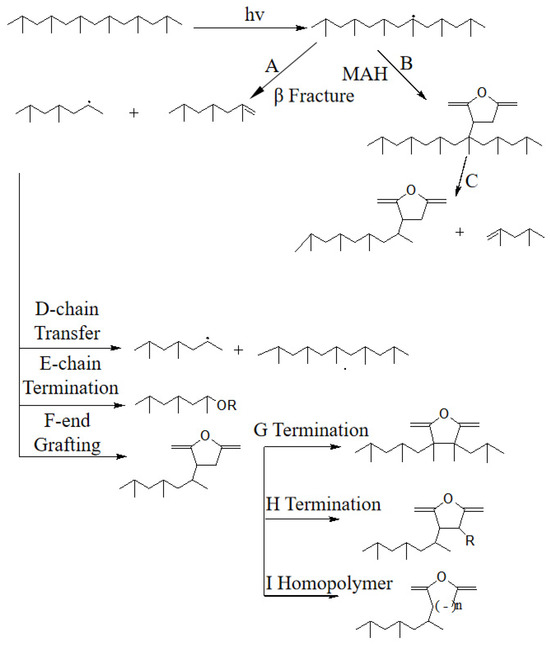
Figure 1.
Ultraviolet grafting process of maleic anhydride onto polypropylene fibers.
2.2. Ultraviolet-Grafted Maleic Anhydride
2.2.1. Grafting Product Preparation Method
The ultraviolet photochemical reaction instrument employed in this study comprises an optical protection dark box, a light source generator, a quartz cold trap, and a mercury lamp. The power of the mercury lamp is adjustable between 0 and 1000 W, and the cooling water circulation device allows for precise temperature control, ranging from −10 °C to 100 °C. The following steps outline the specific procedure for preparing maleic anhydride-grafted polypropylene fibers:
- (1)
- The polypropylene fibers are first soaked in acetone for 24 h to remove surface impurities. After soaking, the acetone is drained, and the fibers are dried in an oven at 60 °C to yield defatted fibers.
- (2)
- A measured amount of the defatted fibers is placed into a quartz tube. A prepared xylene solution containing maleic anhydride and benzophenone is added to the tube in a controlled ratio, and the mixture is left to stand at room temperature for approximately 30 min to allow for uniform dispersion.
- (3)
- The quartz tube is then placed into the ultraviolet photochemical reaction instrument. The power is turned on to activate the UV lamp for a specified period, initiating the grafting reaction. Once the reaction is complete, the lamp is turned off, and the tube is allowed to rest for another 30 min.
- (4)
- After the reaction, the fibers are rinsed with acetone to remove any unreacted substances or by-products. Finally, the fibers are dried in an oven until a constant weight is achieved, indicating the completion of the grafting process and yielding the maleic anhydride-grafted polypropylene fibers.
2.2.2. Determination of Grafting Yield
The grafting yield of polypropylene fibers is determined using the gravimetric method. Before conducting the experiment, a precise amount of fibers is weighed using an analytical balance. Upon completion of the grafting reaction, the fiber products are removed from the reactor, thoroughly cleaned, and dried to ensure that all residual chemicals and by-products are eliminated. The dried fibers are then weighed to obtain their final mass. The grafting yield (GY) of the fibers is calculated using the following equation:
where W0 is the mass of the fibers before grafting (g); Wt is the mass of the purified grafted product (g).
GY = [(Wt − W0)/W0] × 100%
2.2.3. Fiber Ultraviolet-Grafted Maleic Anhydride Test
In this study, the ultraviolet grafting of maleic anhydride onto polypropylene fibers was systematically investigated using three independent variables: the concentration of maleic anhydride (MAC), the mass fraction of benzophenone in the maleic anhydride mixture (BMF), and the exposure time to ultraviolet light (UIT). The GY of the polypropylene fibers served as the response variable. The experimental results obtained from this study are summarized in Table 1.

Table 1.
Results of ultraviolet grafting of maleic anhydride onto polypropylene fibers.
The experimental results reveal that as the concentration of maleic anhydride and the mass fraction of benzophenone in the maleic anhydride mixture increase, the grafting yield of polypropylene fibers initially rises sharply before experiencing a rapid decline. The influence of maleic anhydride concentration on the grafting yield is particularly pronounced, characterized by a steep curve indicative of its significant effect. Similarly, the mass fraction of benzophenone also has a notable impact on grafting yield, as evidenced by a relatively steep curve. In contrast, the exposure time to ultraviolet light has a less substantial effect on the grafting yield of polypropylene fibers, reflected in a more gradual curve. Based on these findings, the optimal grafting conditions are established as follows: a maleic anhydride concentration of 1.2 mol/L, a benzophenone mass fraction of 0.8%, and an ultraviolet light exposure time of 2.25 h. Under these conditions, a sufficient quantity of polypropylene fibers grafted with maleic anhydride (referred to as fiber grafted product) will be produced for subsequent experiments. This optimized grafting process is expected to enhance the compatibility and performance of the polypropylene fibers within cement-stabilized materials.
3. Active Polypropylene Fiber Preparation and Properties
3.1. Activation Principle of Polypropylene Fiber Grafts
The process of grafting reactive maleic anhydride onto the surface of polypropylene fibers effectively enhances the properties of the polymer by improving the weak boundary layer, thereby increasing its chemical reactivity. To facilitate the desired fiber–cement interaction, further modification of the UV-grafted polypropylene fibers is necessary. This involves an amidation reaction with diethylene triamine, resulting in the introduction of amine groups on the fiber surface, which exhibit increased reactivity.
To further augment this reactivity, the amine groups undergo amidation with a dicarboxylic acid, specifically oxalic acid. This modification generates side chains on the polypropylene surface that are rich in active carboxyl functional groups. These newly formed groups enable the modified fibers to chemically interact with cement paste, thereby significantly enhancing the bonding capability between the fibers and the semi-rigid base. The polypropylene fibers used in this study are silver-white in color, with a diameter of approximately 0.02 mm and a length of about 12 mm. The activation process of the polypropylene fiber grafts is illustrated in Figure 2, which provides a visual representation of the modification steps involved in achieving improved reactivity and bonding performance. This multi-step activation process is critical for ensuring the effective integration of the polypropylene fibers into cement-stabilized materials, ultimately enhancing the mechanical properties and durability of the composite material.
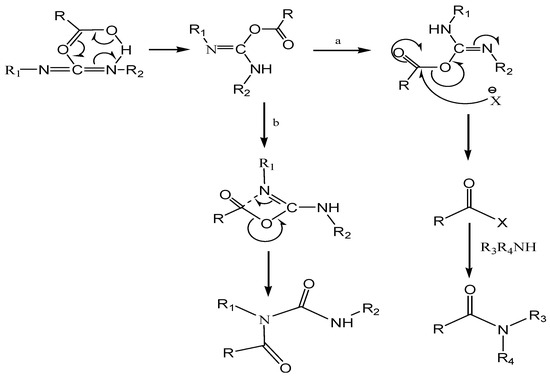
Figure 2.
Activation process of polypropylene fiber grafts.
3.2. Preparation of Active Polypropylene Fibers
3.2.1. Preparation Methods
- (1)
- Accurately weigh a specific amount of the fiber grafts and transfer them into a three-necked flask. Add an appropriate volume of anhydrous ethanol to the flask.
- (2)
- Introduce a predetermined quantity of diethylene triamine and carbodiimide into the flask. Stir the mixture to ensure complete dissolution; then, seal the flask securely.
- (3)
- Position the flask on a heating mantle and heat the mixture to 78 °C, allowing the anhydrous ethanol to reflux. Maintain this temperature for a specified reaction period to ensure proper amidation.
- (4)
- After the reaction time has elapsed, turn off the heating mantle and remove the flask. Filter the solution to separate the liquid phase; then, wash the resulting fibers twice with acetone, followed by multiple rinses with distilled water to eliminate any unreacted materials and by-products.
- (5)
- Dry the washed fibers thoroughly and weigh them to determine the mass of the amidation-modified fiber grafts.
This preparation method ensures the effective modification of the polypropylene fibers, enhancing their reactivity and improving their performance when integrated into cement-based materials.
3.2.2. Determination of Amidation Yield
The amidation yield of the activated polypropylene fibers was determined using elemental analysis to measure the percentage of elemental nitrogen present in the fibers following the amidation process. This nitrogen content was subsequently converted to the mass of diethylene triamine used in the reaction for yield analysis. The procedure is outlined as follows:
- (1)
- Prior to the amidation reaction, accurately weigh a specific amount of fiber grafts using an analytical balance.
- (2)
- After the amidation reaction is complete, thoroughly clean and dry the fibers to remove any unreacted reagents and by-products.
- (3)
- Weigh the dried fibers to obtain the mass after the reaction.
- (4)
- Utilize an elemental analyzer to determine the percentage content of nitrogen in the modified fibers.
The amidation yield (AY) is calculated using the following equation:
where M0 is the mass of the fibers before the amidation reaction (g); Mt is the mass of the purified fibers after the amidation reaction (g); Y is the percentage content of nitrogen in the fibers after the amidation reaction (%).
AY = [(Mt × Y)/0.4078M0] × 100%
3.2.3. Analysis of Fiber Amidation Test Results
Using diethylene triamine concentration (DC), the mass fraction of carbodiimide in diethylene triamine (CDF), and reaction time (RT) as the three independent variables, amdation tests were conducted on the modified polypropylene fibers. The amidation yield (AY) of the active polypropylene fibers served as the response variable. The results of these tests are summarized in Table 2. The test results indicate that as the concentration of diethylene triamine and the mass fraction of carbodiimide in diethylene triamine increase, the amidation yield of the fibers initially rises before eventually declining. Notably, the concentration of diethylene triamine exerts a more substantial influence on the amidation yield compared to other factors, while the reaction time appears to have a relatively minor effect. For the subsequent phases of this study, the optimal amidation conditions were established at a diethylene triamine concentration of 1.8 mol/L, a carbodiimide mass fraction of 1.2% in diethylene triamine, and a reaction time of 6.75 h. Utilizing these conditions, a sufficient quantity of active polypropylene fibers was synthesized for further research. This careful optimization aimed to enhance the chemical reactivity and bonding capabilities of the polypropylene fibers with cement-based materials.

Table 2.
Results of the amidation test of fiber grafts.
3.3. Performance of Active Polypropylene Fibers
3.3.1. FTIR Spectrum Analysis
FTIR spectra of polypropylene fibers, grafted fibers, and active polypropylene fibers were acquired using a Bruker EQUINOX 55 attenuated total reflection infrared spectrometer. The measurements were conducted over a wavelength range of 600–4000 cm−1, and the resulting FTIR spectra are presented in Figure 3. Polypropylene is a saturated hydrocarbon material characterized by asymmetric and symmetric stretching vibrational peaks of CH and CH2 at 2924 cm−1 and 2842 cm−1, respectively, along with a bending vibrational peak of CH2 at 1380 cm−1 and an absorption peak of CH at 1450 cm−1. Notably, the infrared spectrum of polypropylene does not exhibit characteristic carbonyl absorption peaks around 1700 cm−1.
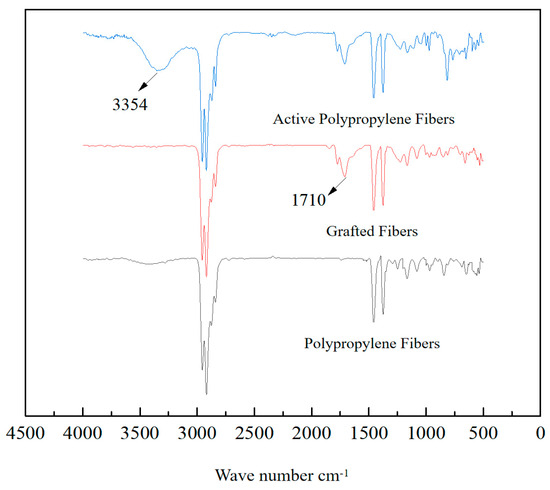
Figure 3.
FTIR spectra of fibers.
Following the grafting of maleic anhydride onto the polypropylene fibers, carbonyl groups are introduced, resulting in a pronounced carbonyl absorption peak at 1710 cm−1 in the FTIR spectrum. In the case of the active polypropylene fibers, a broad absorption peak appears in the range of 3200–3400 cm−1, indicative of the presence of amine and hydroxyl groups. This observation suggests that the fibers have undergone amidation and activation reactions involving carboxyl groups, thereby enhancing their chemical reactivity and potential for bonding with cement paste.
3.3.2. Scanning Electron Microscopy (SEM) Test
To characterize the modification process, polypropylene fiber samples were analyzed both before and after modification. The samples were gold-coated to enhance conductivity and subsequently examined using a Quanta 200 SEM at an acceleration voltage of 10 kV. This examination aimed to observe changes in the surface morphology of the fibers resulting from the modification. The corresponding SEM images are presented in Figure 4. The analysis reveals that the surface of the untreated polypropylene fibers is relatively smooth, exhibiting only a few small particles and scratches, likely a result of production additives and the spinneret used during fiber extrusion. In contrast, the surface of the grafted polypropylene fibers displays a significant presence of dense, particle-like coatings, indicating a marked increase in surface roughness and complexity in morphology. This enhancement in roughness is attributed to the formation of primary free radicals on the polypropylene fibers during the grafting process, which chemically bond with the grafting monomers.
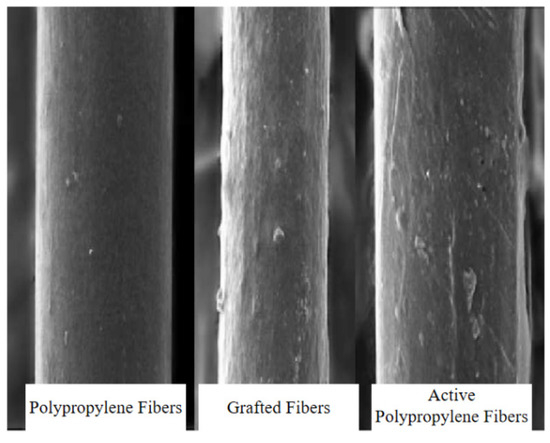
Figure 4.
SEM images of fibers before and after modifications.
For the active polypropylene fibers, the presence of particle-like coatings is diminished, while accumulated deposits are observed. This change is primarily due to the modification process, which introduces a greater number of active carboxyl groups. These groups form weak hydrogen bonds on the surface of the modified fibers, resulting in the formation of larger-molecular-weight hydrogen-bonded polymer coatings. Consequently, this leads to a reduction in the surface roughness of the active polypropylene fibers compared to the grafted fibers, enhancing their compatibility with cement-based materials.
3.3.3. Analysis of Fiber Surface Friction Coefficient
The friction coefficients of polypropylene fibers, fiber grafts, and active polypropylene fibers were evaluated using the capstan method to assess the impact of various modifications on the surface friction characteristics of the fibers. The fiber is wound around the capstan at a certain angle θ, with tension f1 applied at one end and f2 at the other. Due to the frictional force between the fiber and the capstan surface during stretching, the tension f2 is greater than f1. According to the Euler equation, the friction coefficient of the fiber on the capstan can be determined using Equations (3) and (4). The test results are summarized in Table 3.
where are the tensions at both ends of the fiber; is the wrap angle between the fiber and the captan, where should be 180°; is the friction coefficient between the fiber and the capstan.

Table 3.
Comparison of fiber friction coefficients before and after modification.
The findings indicate that following the secondary amidation and activation treatment, the surface friction coefficient of the polypropylene fibers increased when compared to the unmodified fibers. However, this coefficient decreased relative to that of the maleic anhydride-grafted fibers. This observation aligns with the results obtained from the SEM analysis, suggesting that the structural modifications have altered the surface properties of the fibers.
3.3.4. Determination of Water Contact Angle on Fiber Surfaces
The water contact angles of unmodified polypropylene fibers, grafted fibers, and active fibers were measured using a contact angle measuring instrument. A 2 µL droplet of deionized water was dispensed onto the sample surface using a precision syringe. The side view of the droplet was captured with a camera, and the static contact angle between the droplet and the surface was measured using ImageJ 1.53 version software. Each sample was measured 5 to 10 times, and the average value was taken as the result. The results are shown in Figure 5.

Figure 5.
Water contact angle of fibers.
The results indicate that after undergoing ultraviolet grafting with maleic anhydride, amdation, and activation treatments, the water contact angle of the polypropylene fibers decreased significantly, from 106.3° to 60.2°, and further reduced to 39.9°. Wettability is a critical property of solid surfaces and represents a common interface phenomenon in various natural processes. The unmodified polypropylene fibers, lacking polar groups on their surfaces, exhibited a water contact angle exceeding 90°, indicating poor wettability.
Upon grafting maleic anhydride onto the polypropylene fibers using ultraviolet light, a certain quantity of carboxyl (–COOH) groups was introduced to the fiber surface. This modification enhanced the wettability of the fibers, as evidenced by the decrease in water contact angle to 60.2°. Following amidation and activation treatments, the concentration of carboxyl functional groups on the fiber surface increased significantly, resulting in a further reduction in the water contact angle to 39.9°. The introduction of these active polar groups enhanced the wettability of the polypropylene fiber surface by cement slurry, thereby improving the bonding strength between the fibers and the cement matrix.
3.3.5. Tensile Properties Test
According to the requirements of the GB/T 21120-2007 standard [22], the tensile strength and elongation of the fibers were tested using a fiber strength tester. The sample length was 10 mm, and the stretching speed was 10 mm/min. Seven parallel tests were conducted, and the average value of the test results was taken. The tensile performance test results are shown in Table 4. It can be observed that the tensile strength and elongation at break of the fiber-grafted samples experienced slight reductions, with tensile strength decreasing by 4.15% and elongation at break decreasing by 4.85%. This decrease can be attributed to the formation of numerous small defects on the fiber surface during the grafting reaction, which negatively impacts both tensile strength and elongation at break.

Table 4.
Tensile property test results.
Conversely, the amidation and activation processes exert minimal influence on the tensile performance of the fibers. In fact, these processes may slightly enhance the tensile characteristics of the grafted fibers. This improvement is likely due to the extension of maleic anhydride molecular chains and the subsequent linking of carboxyl functional groups, which create weak hydrogen bonding among the grafted molecules on the fiber surface. Consequently, this interaction leads to the formation of a higher-molecular-weight, hydrogen-bonded polymer coating on the fiber surface. This coating compensates to some extent for the damage incurred during the grafting process, resulting in tensile performance that not only does not decrease but may even exhibit a slight trend of improvement.
4. Mechanical Properties of Cement-Stabilized Macadam
4.1. Materials and Test Program
4.1.1. Materials
The aggregate utilized in this study is limestone, selected for its compliance with the technical performance requirements outlined in relevant standards. The cement employed is ordinary Portland cement, classified with a strength grade of 32.5R. The grading composition of the materials is presented in Table 5.

Table 5.
Aggregate grading composition.
4.1.2. Testing Program
The test scheme for cement-stabilized macadam considers four different cement content levels (4%, 5%, 6%, 7%), three different volume contents of active polypropylene fibers (0.6‰, 0.8‰, 1‰), one volume content of ordinary polypropylene fibers (0.8‰), and no polypropylene fiber. Eight test mixes were determined and numbered as follows: GP00-5: no fiber added; PP08-5: cement content of 5%, ordinary polypropylene fiber volume content of 0.8‰; GP06-5, GP08-5, GP10-5: cement content of 5%, active polypropylene fiber volume content of 0.6‰, 0.8‰, and 1‰, respectively; GP06-4, GP06-6, GP06-7: active polypropylene fiber volume content of 0.6%, with cement content of 4%, 6%, and 7%, respectively. The specific scheme is shown in Table 6.

Table 6.
Mix design scheme for cement-stabilized macadam.
4.2. Distribution of Fibers in Cement-Stabilized Macadam
Microscopic observations of the cross-sections of cement-stabilized macadam specimens were conducted using SEM. This analysis focused on two types of specimens: those containing standard polypropylene fibers and those incorporating active polypropylene fibers. The findings are illustrated in Figure 6. The images illustrate that, following the fracture of cement-stabilized macadam specimens containing ordinary polypropylene fibers, the extracted fibers exhibit smooth surfaces with minimal attachment of cement hydration products. The inherent hydrophobicity and smoothness of these polypropylene fibers create noticeable gaps at the interface with the cement matrix, leading to weak chemical bonding and inadequate mechanical interlocking. As a result, these fibers are susceptible to pull-out under stress, which significantly limits their reinforcing effectiveness.
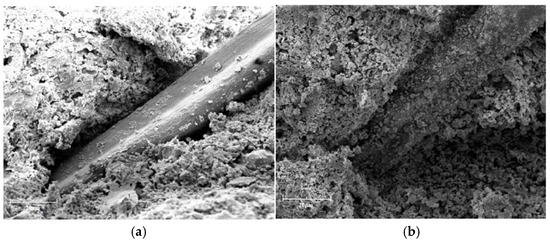
Figure 6.
Microscopic morphology of fiber-enhanced cement-stabilized macadam specimens. (a) is cement-stabilized macadam specimens with ordinary polypropylene fibers; (b) is cement-stabilized macadam specimens with active polypropylene fibers.
In contrast, after the fracture of specimens containing active polypropylene fibers, the fibers are nearly completely coated with cement hydration products, demonstrating robust bonding between the fibers and the cement matrix. This enhanced adhesion is attributed to the introduction of polar –COOH groups on the active polypropylene fibers, which increases surface hydrophilicity and improves wettability with the cement mortar. This modification significantly strengthens the chemical bond between the fibers and the cement matrix. Furthermore, the increased surface roughness of the active polypropylene fibers enhances mechanical interlocking with the cement matrix, thereby allowing these fibers to fully realize their reinforcing potential in the cement-stabilized macadam.
4.3. Test Results and Analysis
According to the requirements of the JTG 3441-2024 specifications [23], standard specimens of cement-stabilized macadam with different mix proportions were prepared for testing, which included standard cubic specimens with dimensions of 150 mm × 150 mm × 150 mm; standard cylindrical specimens with a diameter of 150 mm and a height of 150 mm; and standard beam specimens measuring 400 mm in length, 100 mm in width, and 100 mm in height. Compression strength, tensile strength, and flexural tensile strength tests were conducted, and the test results are presented in Table 7. The effects of these varying mix proportions on the mechanical properties are illustrated in Figure 7, Figure 8, Figure 9 and Figure 10. The findings indicate that active polypropylene fibers significantly enhance the compressive and tensile strengths of cement-stabilized macadam compared to ordinary polypropylene fibers. After a curing period of 28 days, the compressive strength increased by approximately 6.56%, while the tensile strength improved by about 4.94%. In contrast, for cement-stabilized macadam containing ordinary polypropylene fibers, the compressive and tensile strengths increased by 32.5% and 88.5%, respectively, from 7 days to 14 days. Under the same conditions, cement-stabilized macadam with active polypropylene fibers exhibited even greater increases of 54.4% and 135.7% in compressive and tensile strengths. This improvement is attributed to the presence of polar –COOH groups on the surface of the active polypropylene fibers, which enhance hydrophilicity and improve the wettability of the fibers with the cement paste. Consequently, this modification strengthens the chemical bonding between the fibers and the cement matrix. Additionally, the increased surface roughness of the fibers enhances mechanical interlocking with the cement matrix.

Table 7.
Mechanical properties test results of cement-stabilized macadam specimens.
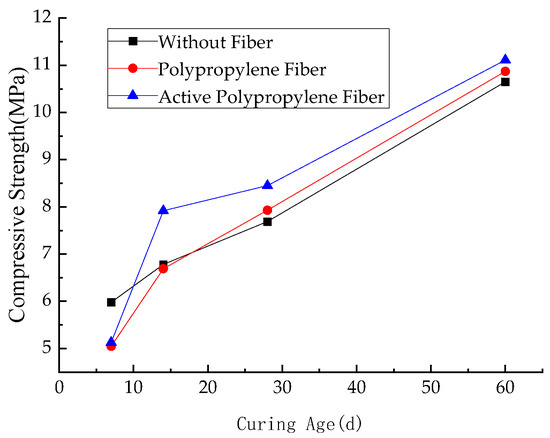
Figure 7.
Trend of compressive strength.
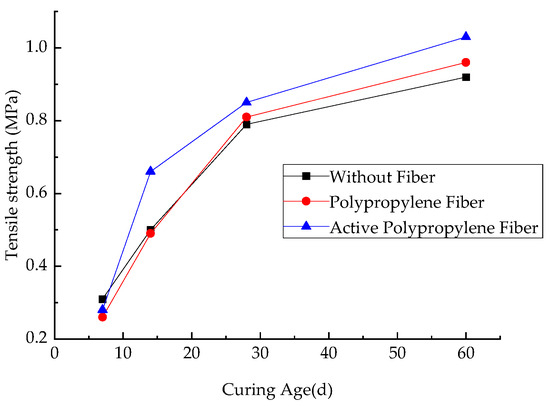
Figure 8.
Trend of tensile strength.
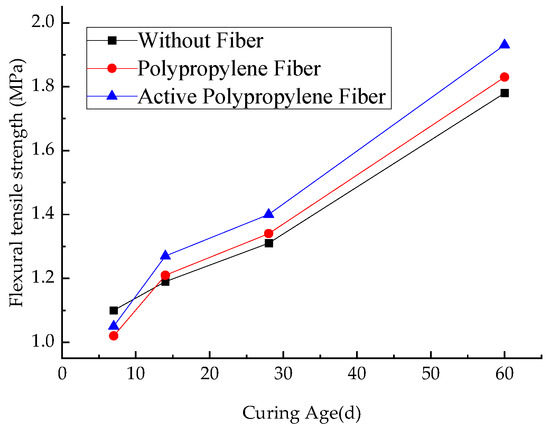
Figure 9.
Trend of flexural tensile strength.
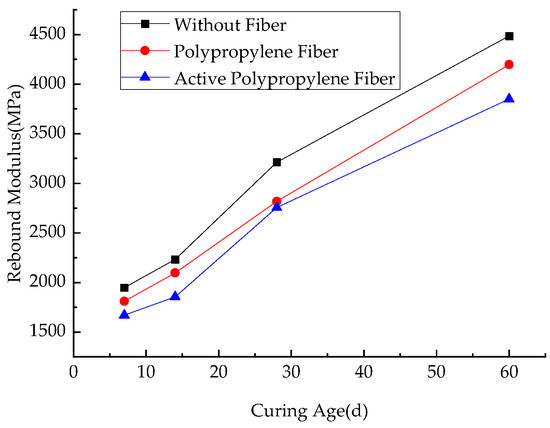
Figure 10.
Trend of rebound modulus.
The 0.8‰ volume content of active polypropylene fibers had a negligible effect on the flexural tensile strength of the cement-stabilized macadam. At 7 days of curing, the cement continued to hydrate, resulting in weaker bonding between the fibers and the matrix. As a result, the flexural tensile strength of the active polypropylene fiber-stabilized macadam was lower than that of the ordinary cement-stabilized macadam. However, after 14 days of curing, the flexural tensile strength of the active polypropylene fiber-stabilized macadam surpassed that of the ordinary cement-stabilized macadam. Furthermore, the incorporation of fibers effectively reduced the rebound modulus of cement-stabilized macadam, with active polypropylene fibers demonstrating a more pronounced reduction. When the volume content of active polypropylene fibers reached 1‰, the rebound modulus decreased from 3213 MPa (without fibers) to 2609 MPa, representing a reduction of 18.80%. This reduction is 7.42% greater than that observed with ordinary polypropylene fibers. This behavior is attributed to the alterations in hydrophilicity and roughness of the activated fiber surface, which enhance the adhesion of the cement-stabilizing material to the fibers, thereby improving the overall stress distribution within the composite. These modifications maximize the toughening effect of the polypropylene fibers, reduce the stiffness of the composite material, and enhance the deformation resistance of the cement-stabilized macadam base.
5. Shrinkage Performance of Cement-Stabilized Macadam
5.1. Test Method
5.1.1. Drying Shrinkage Test
According to JTG 3441-2024 standard test methods and requirements, the drying shrinkage deformation test was conducted using beam specimens measuring 100 mm × 100 mm × 400 mm. Four sets of specimens were prepared with proportions GP00-5, GP08-5, and PP08-5 to evaluate their drying shrinkage strain and shrinkage coefficient at 3, 7, 14, and 28 days. For the remaining five proportions, two sets of specimens were prepared to assess their drying shrinkage strain and shrinkage coefficient at 7 and 28 days. Each set comprised three specimens, and the testing environment was maintained at a temperature of 20 ± 1 °C.
5.1.2. Thermal Shrinkage Test
According to JTG 3441-2024 standard test methods and requirements, the thermal shrinkage test for active polypropylene fiber cement-stabilized macadam utilized beam-shaped specimens with dimensions of 100 mm × 100 mm × 400 mm. Four sets of specimens with proportions GP00-5, GP08-5, and PP08-5 were prepared to measure their thermal shrinkage strains and coefficients at 7, 14, 28, and 60 days. Additionally, two sets of specimens from the other five mix proportions were prepared to evaluate their thermal shrinkage strains and coefficients at 14 and 28 days, with three specimens in each set. Strain gauges with a gauge length of 8 cm and a resistance of 120 Ω were employed to measure the thermal shrinkage coefficient. Data on thermal shrinkage strain were collected automatically through a static strain measurement system connected to a computer. The initial temperature was set to 40 °C and held for approximately 4 h before activating the temperature control program of the test chamber. The cooling rate was established at 0.5 °C/min, with temperature reductions in increments of 10 °C, maintaining a 4 h hold at each step until −20 °C was reached.
5.2. Test Result and Analysis
5.2.1. Dry Shrinkage
For the active polypropylene fiber cement-stabilized macadam in this experiment, the factors significantly influencing drying shrinkage include the specimen’s curing age, cement content, and fiber content. The specific results of the drying shrinkage test are presented in Table 8 and Figure 11. The results indicate that as the volume of active polypropylene fibers increases, the average drying shrinkage coefficient gradually decreases. This reduction can be attributed to the increased number of randomly distributed fibers within the cement-stabilized macadam mixture, which decreases the spacing between adjacent fibers. Consequently, the fibers exert a greater restraining force on the mixture and binder, effectively limiting the drying shrinkage of the composite.

Table 8.
Dry shrinkage test results of cement-stabilized macadam specimens.
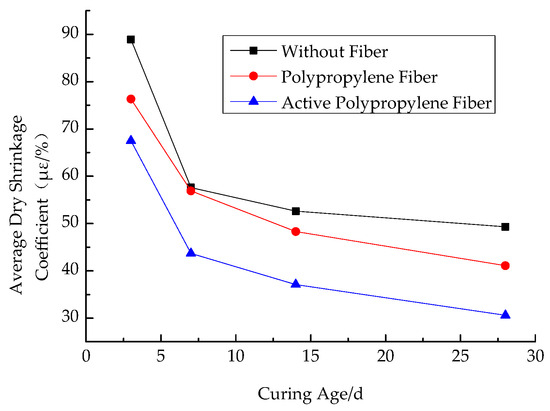
Figure 11.
Dry shrinkage coefficient variation.
Moreover, with the extension of the curing period, the average drying shrinkage coefficient for ordinary cement-stabilized macadam, ordinary polypropylene fiber cement-stabilized macadam, and active polypropylene fiber cement-stabilized macadam all exhibit a decreasing trend. Notably, the active polypropylene fiber cement-stabilized macadam demonstrates a 25.55% reduction in the average drying shrinkage coefficient at 28 days compared to its ordinary polypropylene fiber counterpart. This indicates a stronger bond between the active polypropylene fibers and the stabilized material, as well as a more pronounced toughening and shrinkage resistance effect.
During the initial 7 days following specimen formation, the average drying shrinkage coefficient decreases sharply with age. After this period, the rate of decrease slows, and the coefficient gradually stabilizes. This observation suggests that the drying shrinkage of the cement-stabilized macadam primarily occurs shortly after the mixture is laid and compacted, particularly within the first week. Therefore, it is crucial to implement measures to prevent excessive moisture loss from the base during this initial period to mitigate the risk of drying shrinkage cracks.
5.2.2. Temperature Shrinkage
The temperature shrinkage test was conducted on cement-stabilized aggregates with varying curing ages, cement dosages, and fiber dosages, and the results are presented in Table 9 and Figure 12. The findings indicate that the incorporation of active polypropylene fibers results in a significant reduction in the average temperature shrinkage coefficient of cement-stabilized macadam across all curing ages. As the volume content of active polypropylene fibers increases, the average temperature shrinkage coefficient progressively decreases. Notably, after a 28-day curing period, the average temperature shrinkage coefficient for cement-stabilized macadam with active polypropylene fibers is approximately 15.88% lower than that of the baseline cement-stabilized macadam and 13.16% lower than that of the mix containing ordinary polypropylene fibers. This demonstrates that active polypropylene fibers are more effective in mitigating temperature-induced shrinkage in cement-stabilized macadam.

Table 9.
Temperature shrinkage test results.
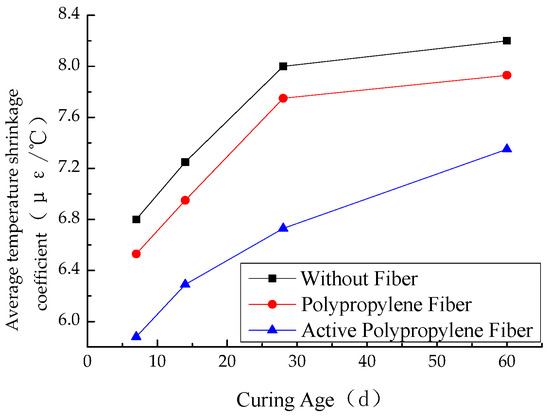
Figure 12.
Variation in temperature shrinkage coefficient.
The observed improvement can be attributed to the significantly enhanced interfacial bond strength between the active polypropylene fibers and the cement matrix when compared to ordinary polypropylene fibers. As a result, during instances of shrinkage-induced cracking, a greater amount of energy is required to pull or rupture the active polypropylene fibers from the cement matrix. This leads to a more pronounced toughening effect, thereby increasing the overall resilience of the cement-stabilized macadam.
6. Conclusions
- (1)
- Active polypropylene fibers were synthesized through UV grafting and surface functional group activation methods. FTIR spectroscopy confirmed the success of these modifications, as evidenced by a strong carbonyl absorption peak at 1710 cm−1 and a broad peak in the range of 3200–3400 cm−1. These results indicate the effective grafting and activation reactions involving carboxyl groups on the polypropylene surface. SEM analysis further revealed the presence of aggregated deposits on the surface of the activated fibers, significantly increasing their specific surface area.
- (2)
- Water contact angle measurements demonstrated a substantial decrease in the contact angle of the activated polypropylene fibers from 106.3° to 39.9°. This indicates that the introduction of carboxyl groups significantly improved the wettability of the cement slurry on the fiber surface, thereby enhancing the bonding strength between the fibers and the cement matrix. Also, the tensile performance tests indicated that the grafting and activation reactions had a minimal impact on the tensile strength and elongation at break of the polypropylene fibers.
- (3)
- The compressive and tensile strengths of cement-stabilized macadam incorporating active polypropylene fibers were found to be superior to those with ordinary polypropylene fibers. After 28 days, the compressive strength increased by approximately 6.56%, while the tensile strength rose by about 4.94%. Concurrently, the rebound modulus exhibited a reduction of around 7.4%. These enhancements can be attributed primarily to the introduction of amide groups on the active polypropylene fibers, which increased the hydrophilicity of the fiber surface, improved wettability with the cement paste, and strengthened the chemical bonding between the fibers and the cement matrix.
- (4)
- The incorporation of active polypropylene fibers effectively mitigated both the drying shrinkage and temperature shrinkage coefficients of cement-stabilized macadam. Compared to ordinary polypropylene fibers, the drying shrinkage coefficient was reduced by 25.55%, while the temperature shrinkage coefficient decreased by 13.16%. These findings indicate that active poly-propylene fibers form a stronger bond with the stabilizing material, thereby enhancing the fibers’ toughening and shrinkage-resistant properties. These results confirmed the superiority of fiber surface activation treatment in enhancing the crack resistance of cement-stabilized macadam.
Author Contributions
Conceptualization, H.C. and T.C.; methodology, H.C.; validation, J.L., T.C. and H.C.; formal analysis, H.C.; resources, T.C.; data curation, H.R.; writing—original draft preparation, J.L.; writing—review and editing, H.C.; visualization, Z.Q.; supervision, J.L.; project administration, H.C. All authors have read and agreed to the published version of the manuscript.
Funding
This research was funded by National Key R&D Program of China, grant number 2022YFB2601900; National Natural Science Foundation of China, grant number 52178419.
Data Availability Statement
Data will be made available on reasonable request.
Acknowledgments
Thanks are also extended to Meng Fan and Yapeng Yan, who proposed the idea of the performance test in the current study.
Conflicts of Interest
Author Jing Li was employed by the company Qinghai Provincial Transportation Planning and Design Institute Co., Ltd. The remaining authors declare that the research was conducted in the absence of any commercial or financial relationships that could be construed as a potential conflict of interest.
References
- Wang, X.; Huang, X.; Bian, G. Analysis of the mechanism of reflective cracking in semi-rigid base asphalt pavements using LSPM. Highw. Traffic Sci. Technol. 2016, 33, 12–18. [Google Scholar]
- Liu, X.; Wu, J.; Zhao, X.; Yan, P.; Ji, W. Effect of brick waste content on mechanical properties of mixed recycled concrete. Constr. Build. Mater. 2021, 292, 123320. [Google Scholar] [CrossRef]
- Song, J.; Xu, C. Experimental study on the performance of fiber-reinforced cement-stabilized aggregates with different aggregates. Highway 2022, 67, 237–241. [Google Scholar]
- Qiu, X. Study on the performance of cement-stabilized macadam base with polyester fiber. Shandong Transp. Sci. Technol. 2019, 68–70+77. [Google Scholar]
- Liu, Z.; Wang, D.; Wei, X.; Wang, L. Impact of fiber diameter on road performance of cement-stabilized macadam. Balt. J. Road Bridge Eng. 2017, 12, 12–20. [Google Scholar] [CrossRef]
- Hu, Y.; Tao, Z.; Zhou, Z. Study on the road performance of rubber powder and fiber composite modified cement stabilized macadam. Highway 2024, 69, 36–42. [Google Scholar]
- Guo, Y.; Liu, Y.; Shen, A. Study on shrinkage and crack resistance of glass fiber reinforced cement stabilized macadam. J. Zhengzhou Univ. (Eng. Ed.) 2023, 44, 114–120. [Google Scholar]
- Zhao, C.; Liang, N.; Zhu, X.; Yuan, L.; Zhou, B. Fiber-reinforced cement-stabilized macadam with various polyvinyl alcohol fiber contents and lengths. J. Mater. Civ. Eng. 2020, 32, 04020312. [Google Scholar] [CrossRef]
- Li, C.; Zhou, H.; Guo, C. Influence of basalt fiber on mechanical properties of permeable cement stabilized macadam base. IOP Conf. Ser. Earth Environ. Sci. 2021, 651, 032004. [Google Scholar] [CrossRef]
- Zhang, C.; Wu, W.; Chen, R.J. Experimental study on the deformation performance of cement-stabilized macadam reinforced with fiber. Adv. Mater. Res. 2011, 335, 391–395. [Google Scholar] [CrossRef]
- Zhang, Y.; Gu, Z.; Li, H. Toughening study of fiber cement-stabilized crushed pebble based on crack strain energy balance principle. China J. Highw. 2023, 36, 197–208. [Google Scholar] [CrossRef]
- Zhang, P.; Liu, C.; Li, Q. Experimental study on the mechanical properties of polypropylene fiber cement stabilized macadam. J. Zhengzhou Univ. (Eng. Ed.) 2010, 31, 44–47. [Google Scholar]
- Li, Y.; Li, X.; Lv, R. Effects of expansive agents and polypropylene fibers on mechanical properties of cement-stabilized macadam. Highway 2011, 56, 143–146. [Google Scholar]
- Fu, C.; Qi, S. Study on the mechanical properties of polyester and polypropylene fiber cement-stabilized macadam. Highway 2015, 60, 37–42. [Google Scholar]
- Zhao, Y.; Yang, X.; Zhang, Q.; Liang, N.; Xiang, Y.; Qin, M. Crack resistance and mechanical properties of polyvinyl alcohol fiber-reinforced cement-stabilized macadam base. Adv. Civ. Eng. 2020, 2020, 6564076. [Google Scholar] [CrossRef]
- Li, Q.; Liu, L.; Li, Y.; Wu, C. Effect of fiber on mechanical properties of cement-stabilized macadam mixture. J. Phys. Conf. Ser. 2021, 2044, 012045. [Google Scholar] [CrossRef]
- Hadi Sahlabadi, S.; Bayat, M.; Mousivand, M.; Saadat, M. Freeze-thaw durability of cement-stabilized soil reinforced with polypropylene/basalt fibers. J. Mater. Civ. Eng. 2021, 33, 04021232. [Google Scholar] [CrossRef]
- Cheng, C. Hydrophilic Modification and Characterization of Polypropylene. Master’s Thesis, Northwest Normal University, Lanzhou, China, 2009. [Google Scholar]
- Zhang, Z.; Yang, J.; Jin, Z. Influence of nano-SiO2 modified glass fiber surface on the interfacial performance of glass fiber/polypropylene composites. J. Beijing Univ. Chem. Technol. (Nat. Sci. Ed.) 2016, 43, 53–59. [Google Scholar]
- Zhu, Y.; Song, M.; Gou, H. Mechanical properties of silica fume-modified polypropylene fiber self-compacting concrete. China Sci. 2020, 15, 1401–1404. [Google Scholar]
- Li, D.; Zhao, B.; Chen, K.; Wang, F.; Zhang, J.; Zhang, F.; Pan, K. Research progress on the preparation and application of hollow polypropylene fibers. China Plast. 2023, 37, 109. [Google Scholar]
- GB/T 21120-2018; Synthetic Fibers Are Used for Cement Concrete and Mortar. Standards Press of China: Beijing, China, 2018.
- JTG 3441-2024; Test Methods of Materials Stabilized with Inorganic Binders for Highway Engineering. Ministry of Transport: Beijing, China, 2024.
Disclaimer/Publisher’s Note: The statements, opinions and data contained in all publications are solely those of the individual author(s) and contributor(s) and not of MDPI and/or the editor(s). MDPI and/or the editor(s) disclaim responsibility for any injury to people or property resulting from any ideas, methods, instructions or products referred to in the content. |
© 2024 by the authors. Licensee MDPI, Basel, Switzerland. This article is an open access article distributed under the terms and conditions of the Creative Commons Attribution (CC BY) license (https://creativecommons.org/licenses/by/4.0/).